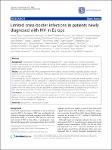Limited cross-border infections in patients newly diagnosed with HIV in Europe
Frentz, Dineke
Wensing, Annemarie M. J.
Albert, Jan
Paraskevis, Dimitrios
Abecasis, Ana B.
Hamouda, Osamah
Jørgensen, Louise B.
Kücherer, Claudia
Struck, Daniel
Schmit, Jean-Claude
Åsjö, Birgitta
Balotta, Claudia
Beshkov, Danail
Camacho, Ricardo J.
Clotet, Bonaventura
Coughlan, Suzie
Wit, Stéphane De
Griskevicius, Algirdas
Grossman, Zehava
Horban, Andrzej
Kolupajeva, Tatjana
Korn, Klaus
Kostrikis, Leondios G.
Liitsola, Kirsi
Linka, Marek
Background: International travel plays a role in the spread of HIV-1 across Europe. It is, however, not known whether international travel is more important for spread of the epidemic as compared to endogenous infections within single countries. In this study, phylogenetic associations among HIV of newly diagnosed patients were determined across Europe. Results: Data came from the SPREAD programme which collects samples of newly diagnosed patients that are representative for national HIV epidemics. 4260 pol sequences from 25 European countries and Israel collected in 2002–2007 were included. We identified 457 clusters including 1330 persons (31.2% of all patients). The cluster size ranged between 2 and 28. A number of 987 patients (74.2%) were part of a cluster that consisted only of patients originating from the same country. In addition, 135 patients (10.2%) were in a cluster including only individuals from neighboring countries. Finally, 208 patients (15.6%) clustered with individuals from countries without a common border. Clustering with patients from the same country was less prevalent in patients being infected with B subtype (P-value
No license information

